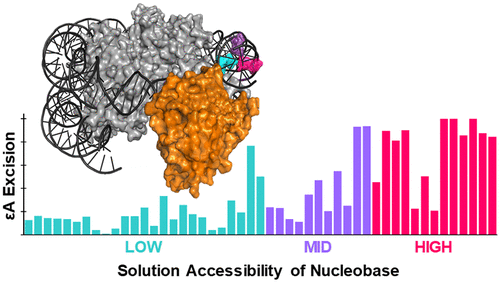当前位置:
X-MOL 学术
›
ACS Chem. Biol.
›
论文详情
Our official English website, www.x-mol.net, welcomes your
feedback! (Note: you will need to create a separate account there.)
Global Repair Profile of Human Alkyladenine DNA Glycosylase on Nucleosomes Reveals DNA Packaging Effects.
ACS Chemical Biology ( IF 3.5 ) Pub Date : 2019-07-22 , DOI: 10.1021/acschembio.9b00263 Erin E Kennedy 1 , Chuxuan Li 2 , Sarah Delaney 1, 2
ACS Chemical Biology ( IF 3.5 ) Pub Date : 2019-07-22 , DOI: 10.1021/acschembio.9b00263 Erin E Kennedy 1 , Chuxuan Li 2 , Sarah Delaney 1, 2
Affiliation

|
Alkyladenine DNA glycosylase (AAG) is the only known human glycosylase capable of excising alkylated purines from DNA, including the highly mutagenic 1,N6-ethenoadenine (εA) lesion. Here, we examine the ability of AAG to excise εA from a nucleosome core particle (NCP), which is the primary repeating unit of DNA packaging in eukaryotes. Using chemical synthesis techniques, we assembled a global population of NCPs in which A is replaced with εA. While each NCP contains no more than one εA lesion, the total population contains εA in 49 distinct geometric positions. Using this global εA-containing NCP system, we obtained kinetic parameters of AAG throughout the NCP architecture. We observed monophasic reaction kinetics across the NCP, but varying amounts of AAG excision. AAG activity is correlated with solution accessibility and local histone architecture. Notably, we identified some highly solution-accessible lesions that are not repaired well, and an increase in repair within the region of asymmetric unwrapping of the nucleosomal DNA end. These observations support in vivo work and provide molecular-level insight into the relationship between repair and NCP architecture.
中文翻译:

人烷基烷基腺苷酸糖基化酶对核小体的全球修复概况揭示了DNA包装效果。
烷基腺嘌呤DNA糖基化酶(AAG)是唯一已知的能够从DNA中切除烷基化嘌呤的人糖基化酶,包括高度诱变的1,N6-乙炔腺嘌呤(εA)病变。在这里,我们研究了AAG从核小体核心颗粒(NCP)中切除εA的能力,核小体核心颗粒是真核生物中DNA包装的主要重复单元。使用化学合成技术,我们组装了NCP的全球群体,其中A被εA取代。虽然每个NCP包含不超过一个εA病变,但总人群在49个不同的几何位置包含εA。使用这种包含εA的全局NCP系统,我们获得了整个NCP体系结构中AAG的动力学参数。我们观察到整个NCP的单相反应动力学,但AAG切除量不同。AAG活动与解决方案可访问性和本地组蛋白架构相关。值得注意的是,我们发现了一些无法很好修复的高度可溶液接触的损伤,以及核小体DNA末端不对称解缠区域内修复的增加。这些观察结果支持体内工作,并提供修复和NCP结构之间关系的分子水平见解。
更新日期:2019-07-16
中文翻译:

人烷基烷基腺苷酸糖基化酶对核小体的全球修复概况揭示了DNA包装效果。
烷基腺嘌呤DNA糖基化酶(AAG)是唯一已知的能够从DNA中切除烷基化嘌呤的人糖基化酶,包括高度诱变的1,N6-乙炔腺嘌呤(εA)病变。在这里,我们研究了AAG从核小体核心颗粒(NCP)中切除εA的能力,核小体核心颗粒是真核生物中DNA包装的主要重复单元。使用化学合成技术,我们组装了NCP的全球群体,其中A被εA取代。虽然每个NCP包含不超过一个εA病变,但总人群在49个不同的几何位置包含εA。使用这种包含εA的全局NCP系统,我们获得了整个NCP体系结构中AAG的动力学参数。我们观察到整个NCP的单相反应动力学,但AAG切除量不同。AAG活动与解决方案可访问性和本地组蛋白架构相关。值得注意的是,我们发现了一些无法很好修复的高度可溶液接触的损伤,以及核小体DNA末端不对称解缠区域内修复的增加。这些观察结果支持体内工作,并提供修复和NCP结构之间关系的分子水平见解。


















































 京公网安备 11010802027423号
京公网安备 11010802027423号